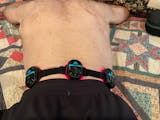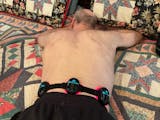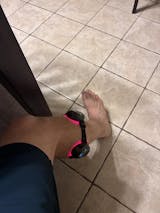Knee pain is a common problem that many people experience at some point in their lives. Whether it’s caused by an injury, arthritis, or overuse, knee pain can be both frustrating and debilitating. Understanding the possible causes of knee pain is essential in finding the right treatment.
Medical-grade red light therapy devices have emerged as an effective solution for relieving knee pain and promoting faster healing. In this article, we’ll explore the main causes of knee pain and how red light therapy can help ease the discomfort.
Common Causes of Knee Pain
Understanding what might be causing your knee pain is the first step to treatment.
Osteoarthritis
Osteoarthritis (OA) is a common cause of knee pain, especially in older adults. OA occurs when the cartilage that cushions the knee joint begins to wear down, causing the bones to rub together. This leads to pain, stiffness, and swelling in the knee. OA can make simple movements like walking or climbing stairs difficult, and it often worsens over time. Using red light therapy devices for home use can help reduce inflammation and promote healing in the affected tissues, providing relief.
Injuries and Trauma
Knee pain can also be caused by injuries, such as sprains, strains, or fractures. Sports accidents, falls, or sudden twisting movements can result in significant pain and damage to the knee. These injuries may involve ligaments, tendons, or the cartilage.
FDA approved red light therapy can accelerate the healing process by increasing blood circulation to the injured area, helping to reduce pain and speed up tissue repair.
Patellar Tendonitis
Patellar tendonitis, also known as jumper's knee, occurs when the tendon connecting the kneecap to the shinbone becomes inflamed. This condition is common in athletes who perform repetitive jumping activities, such as basketball or volleyball. The pain typically worsens with movement and can limit your ability to exercise or perform daily activities. Red light therapy devices can help reduce inflammation in the tendon and relieve pain by stimulating healing at the cellular level.
Bursitis
Knee bursitis occurs when the small, fluid-filled sacs (bursae) around the knee become inflamed, often due to overuse or prolonged pressure. This condition is common in people who spend a lot of time kneeling or bending their knees. Bursitis causes swelling and pain in the knee, making it difficult to move the joint. Medical grade red light therapy can reduce swelling and promote faster recovery by increasing blood flow and stimulating tissue repair.
How Medical-Grade Red Light Therapy Devices Help Relieve Knee Pain
Red light therapy can be an effective, non-invasive treatment for knee pain, offering several benefits.
Reducing Inflammation
One of the key benefits of red light therapy is its ability to reduce inflammation. Knee pain is often caused by swelling and irritation in the tissues around the joint. Red light therapy works by penetrating deep into the tissue, triggering a healing response at the cellular level. This helps to decrease inflammation, which can relieve pain and improve mobility.
Medical-grade red light therapy devices - PRUNGO FluxGo are designed to provide effective treatment for various types of knee pain, including arthritis and tendonitis.
Accelerating Tissue Healing
Red light therapy has been shown to accelerate the healing of damaged tissues. When you experience knee pain due to injury or wear and tear, red light therapy helps stimulate the production of collagen and other important healing proteins. This promotes tissue regeneration and speeds up the repair process. Whether it’s healing a sprain, a strain, or post-surgery recovery, red light therapy can play a vital role in reducing recovery time.
Enhancing Blood Circulation
Red light therapy also improves blood circulation to the knee area. This increased blood flow helps deliver essential nutrients and oxygen to the damaged tissues, promoting faster healing. By enhancing circulation, red light therapy can also help reduce the sensation of stiffness or tightness around the knee joint, making it easier to move and perform daily activities.
When Should You Seek Medical Attention for Knee Pain?
While red light therapy can help with many types of knee pain, there are times when it’s necessary to seek professional medical advice.
Persistent Pain
If your knee pain doesn’t improve after several days of rest and self-care, it might indicate a more serious issue. Conditions like torn ligaments or cartilage can require medical intervention. If you’ve been using red light therapy but the pain persists or worsens, it’s important to consult a healthcare professional for a thorough examination and diagnosis.
Swelling and Instability
Swelling, instability, or a feeling that your knee is “giving way” can be signs of a more severe injury, such as an ACL tear or meniscus damage. If these symptoms occur, it’s important to seek medical attention right away. Red light therapy may be beneficial in reducing inflammation, but a medical professional can provide a proper diagnosis and treatment plan for more serious knee issues.
Difficulty Moving the Knee
If you’re unable to bend or straighten your knee fully, this may point to a more significant injury or joint issue. Sometimes, knee pain can be caused by something as serious as a dislocated kneecap or a fracture. In these cases, medical intervention is essential, though red light therapy can still be a helpful adjunct to the treatment process.
Can Overuse Lead to Knee Pain?
Overuse injuries are a common cause of knee pain, particularly for athletes and active individuals.
Repetitive Strain
If you perform repetitive activities like running, jumping, or squatting, you may be at risk for overuse injuries. The constant stress on the knee joint can cause wear and tear, leading to conditions like tendinitis or bursitis. Red light therapy can help reduce the strain on the knee and relieve pain caused by overuse by promoting healing and improving flexibility in the joint.
Poor Technique
Using improper form during exercises or physical activities can place undue stress on your knees, increasing the risk of injury. Poor posture, incorrect squatting technique, or misaligned foot positioning can lead to long-term knee pain. Red light therapy can help by alleviating some of the pain caused by misalignment and speeding up recovery.
Lack of Recovery
Not allowing enough time for your knees to rest and recover between workouts can increase the risk of injury. This is especially true for high-intensity or high-impact activities. If you don’t give your knees time to heal, you’re more likely to develop chronic pain. Red light therapy can aid recovery by stimulating cellular repair and reducing inflammation after strenuous activity.
Risk Factors for Knee Pain
Certain factors can increase your likelihood of experiencing knee pain.
Age
As you get older, the cartilage in your knees naturally begins to wear down, which can lead to osteoarthritis and other joint problems. This age-related wear and tear can cause knee pain, especially when engaging in physical activities. Using red light therapy can help slow down the degeneration of tissues and relieve pain caused by aging joints.
Obesity
Being overweight places additional strain on your knees, increasing the risk of knee pain and joint problems. The added weight can accelerate the breakdown of cartilage, leading to arthritis. Red light therapy can reduce inflammation and improve circulation, providing relief to those with knee pain caused by excess weight.
Genetics
Some people are genetically predisposed to knee issues, such as arthritis or ligament injuries. If knee pain runs in your family, you may be more likely to experience it yourself. While red light therapy may help alleviate pain, it’s important to take preventive measures, like maintaining a healthy weight and staying active, to reduce the impact of genetic factors.

Conclusion
Knee pain can be caused by a variety of factors, including injury, overuse, or degenerative conditions such as osteoarthritis. Understanding the root cause of the pain is crucial for finding the right treatment. While traditional methods such as rest and ice packs are important, incorporating medical-grade red light therapy into your daily life can significantly relieve pain. Red light therapy works by reducing inflammation, improving blood circulation, and accelerating tissue healing, helping you recover faster and reducing pain.
Red light panels are a good option when you need to cover a wide area; and for facial care,
red light masks effectively cover multiple facial areas, are particularly suitable for soothing and repairing, and help improve skin condition.

























0 comments